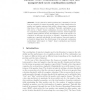Free Online Productivity Tools
i2Speak
i2Symbol
i2OCR
iTex2Img
iWeb2Print
iWeb2Shot
i2Type
iPdf2Split
iPdf2Merge
i2Bopomofo
i2Arabic
i2Style
i2Image
i2PDF
iLatex2Rtf
Sci2ools
MLDM
2009
Springer
2009
Springer
Dynamic Score Combination: A Supervised and Unsupervised Score Combination Method
In two-class score-based problems the combination of scores from an ensemble of experts is generally used to obtain distributions for positive and negative patterns that exhibit a larger degree of separation than those of the scores to be combined. Typically, combination is carried out by a “static” linear combination of scores, where the weights are computed by maximising a performance function. These weights are equal for all the patterns, as they are assigned to each of the expert to be combined. In this paper we propose a “dynamic” formulation where the weights are computed individually for each pattern. Reported results on a biometric dataset show the effectiveness of the proposed combination methodology with respect to “static” linear combinations and trained combination rules.
Linear Combinations | Machine Learning | MLDM 2009 | Trained Combination Rules | Two-class Score-based Problems |
Related Content
| Added | 27 May 2010 |
| Updated | 27 May 2010 |
| Type | Conference |
| Year | 2009 |
| Where | MLDM |
| Authors | Roberto Tronci, Giorgio Giacinto, Fabio Roli |
Comments (0)

